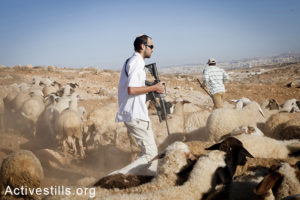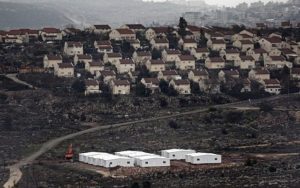How Settlers Use Flocks of Sheep to Take Over Palestinian Land

A Jewish settler from the illegal settlement of Mitzpe Yair chases the flock and threatens the Palestinian shepherds
Amira Haas writes in Haaretz (the entire article is printed below)
“The letter below, which was originally sent by email, was received by Haaretz on Wednesday – but without the writer’s address. It opens: “Residents of Alon, we are happy to share with you the temporary takeover of land for a Hebrew flock of sheep near the settlement for a period of about three months.” The letter was signed “Srulik, the settlement’s secretary.” Apparently this is Srulik Hirsch and the settlement’s website hasn’t updated the secretary’s name. Alon is an offshoot of Kfar Adumim, another settlement.”
When I called to ask about the letter, Srulik answered immediately: “I know nothing about it.” He asked who gave me the information and said “I don’t know who passed something on to you and what he passed on to you.” He said he’d call later after he had confirmed the details.
So here are the details, as they appear in the letter. Authentic or not, the details correspond to the way at least 10 other outposts throughout the West Bank have been built around a flock of sheep. Young people lead the flock, amid a family or two with children, with the considerable help of government agencies behind the scenes.
The details confirm what has been concluded in the past. These aren’t private initiatives by eccentrics. A flock is an expensive thing – around 1,650 shekels ($455) a sheep – and there are several hundred sheep in each flock.
The letter – even if not penned by “Srulik” – explains well the rationale behind the shepherds’ outposts: Grab as much Palestinian land as possible as fast as possible (and much more than by building houses). After all, the Hebrew flocks of sheep in the West Bank are a synonym for terrorizing anyone who’s a non-Hebrew shepherd or farmer.
The letter says further down: “In accordance with the desire to keep in the council’s jurisdiction the state land around the settlement and in Gush Adumim, and in continuing the farming activity developing the area (the olive groves and flock of sheep grazing at Mishor Adumim), another flock has been set up that will graze from Alon Road east to Mitzpeh Yericho, on the border of Wadi Qelt, and up to Route 1. All this is part of the desire to create a contiguity of settlements from Mishor Adumim to Mitzpeh Yericho.
“Since the flock already exists and all the permits for the pen’s final location have not been obtained, we have asked for a temporary permit to place the flock east of the settlement (in the [military] academy’s future location). This is a temporary solution for only three months in which the flock will graze and get used to the place. We point out that a grazing permit has been obtained from the legal authorities and the Civil Administration. The entire flock numbers some 200 sheep, in addition to two Jewish families with children who will live in trucks on wheels [sic], with youths who will look after the flock.
“To maintain the families and the flock, basic infrastructure work will be carried out – a road, water and the like. Boaz Ido and Zambish [Ze’ev Hever] of Amana [the settling agency of the Gush Emunim settler movement] were partners to carrying out the idea, financing the enterprise and implementing it. To receive further details and submit additional, updated details, you are all invited to a discussion evening on the subject with Boaz Ido in the library on Wednesday October 17 at 9 (please come on time).
“The program is in coordination with and has the approval of the settlement’s security coordinator, Yishai. The settlement’s secretariat, Srulik the settlement secretary.”

prefabricated outpost homes under construction
There in black and white
Again, Srulik says he doesn’t know about this. Boaz Ido didn’t answer the phone or the text message I sent him. By the way, he’s is the owner of a commercial outpost filled with illegal structures near Alon called Eretz Bereshit.
I tried to find out what a grazing permit is and if the flock at Alon had been granted one. I was told that the Civil Administration doesn’t have a department that grants grazing permits, and that the World Zionist Organization’s Settlement Division grants grazing permits in the West Bank. The division’s job is to set up rural communities to strengthen the periphery of the State of Israel, above all in the West Bank outside the borders of the State of Israel.
In 2015, the Knesset stipulated by law that the division is Israel’s official settlement agency. It is supervised by the Agriculture Ministry, headed by Minister Uri Ariel, a settler from Kfar Adumim, who already at the end of the ‘70s hatched a plan to expand the settlements in the Khan al-Ahmar (Ma’aleh Adumim) area by evicting all the local Bedouin communities.
There is no grazing permit from the Civil Administration, but there is certainly an approved plan for an “academy” some 120 meters (394 feet) from Alon’s built-up area. A plywood bulletin board with two printed pages on it – one in Hebrew and one in Arabic – was there Thursday, stuck in the heart of the emptiness and rocks east of the settlement.
The pages are still white, a sign they were put up recently. They’re signed by architect Natalia Averbuch, chairwoman of the subcommittee for settlement at the Civil Administration’s Supreme Planning Council, Judea and Samaria Region. The pages are not dated. In the notice, Averbuch announces the validity of the academy plan, which the Supreme Planning Council itself approved on August 2.
From council meetings that took place earlier, it turns out that this is a structure for a pre-military academy, which already exists, in mobile structures in Alon. Once the academy is taken out of the settlement, more room will be made for additional housing units while widening the settlement’s perimeter.
Construction will be coordinated with the Israel Nature and Parks Authority. The topography isn’t easy, it was noted in the discussion. It was also noted that this is a private institution, while the lot was intended for public structures. But apparently this hurdle was overcome.
Deliberate intent to mislead
On the Finance Ministry’s planning-administration website, where the details of the construction plan beyond the Green Line appear transparently, it says the plot is in the area of the village of Anata. But the plan by architect Uriel Rosenheim of Jerusalem says the landowner is “the custodian of abandoned government property in the Judea and Samaria area.” According to the plan, the developer is the World Zionist Organization – the Settlement Division.
I sent a question to the Settlement Division; when the answer comes, we’ll publish it. I didn’t write to Ze’ev Hever of Amana, or to Yishai, the security coordinator.
The costs can be estimated from those of another outpost, Havat Pnei Kedem, which aspires to expand to 400 sheep. As its website testifies, with commendable transparency, the project costs some 800,000 shekels, including fencing, an all-terrain vehicle, a week’s work with the vehicle, a guard at night and a security-camera system.
It also says the settlers are acting “with the full cooperation of the Gush Etztion Regional Council and Zionist Organization. Together with the Agriculture Ministry and professional and business consultants, we have crafted a business plan for raising a flock of 400 sheep.”
So why is there no transparency about Alon’s planned shepherds’ outpost?
Since no one has responded to me, everything is guesswork; for example, that the letter is merely a hologram of similar existing outposts. So as not to repeat the mistakes of outposts that were set up on private Palestinian land, leading to problems and legal proceedings, outposts of recent years were built on public Palestinian land, which, with deliberate intent to mislead, is called in Israel state land. The state’s institutions abet the construction in every way while turning a blind eye.
Take, for example, two shepherds’ outposts in the northern Jordan Valley. Similar to the outpost described in the letter, they consist of sheep, young people and Jewish families with children. One outpost is located east of an older outpost that has been sanitized, Givat Salit. The other is located in the Um Zuqa nature reserve. The Civil Administration said they were both unauthorized and that demolition orders had been issued for them.
More than two years have passed and the two outposts are thriving; they are connected to the electricity, water and road networks. “The young people and Jewish families,” armed, walk with the flocks in a very wide area, intimidating Palestinian farmers and shepherds in the region, so much so they’re afraid to graze their flocks and cultivate their land.
Between Alon and Mitzpeh Jericho there are Bedouin shepherds’ communities. One is the Jahalin al-Hilu at Khan al-Ahmar. According to persistent rumors, the community’s structures will be destroyed and its residents will be evicted to the landfill site next week. The settlements of Kfar Adumin and Alon were the first to demand that the High Court of Justice order this demolition, and the justices abided.”
